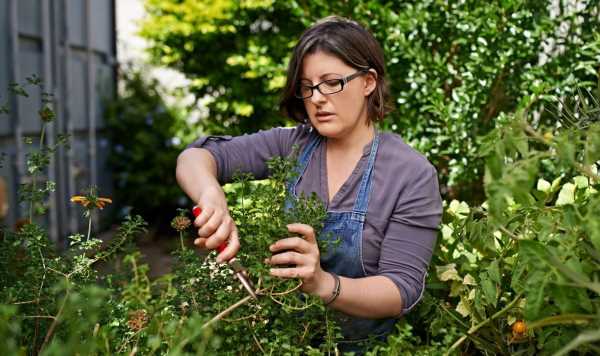Homebase offers advice for preparing your lawn in March
We use your sign-up to provide content in ways you’ve consented to and to improve our understanding of you. This may include adverts from us and 3rd parties based on our understanding. You can unsubscribe at any time. More info
Sunny and longer days bring a whole range of gardening tasks that can be completed in March. Even though it is getting warmer, keep an eye on the weather forecast as March is prone to good ground frosts, which may catch gardeners out and potentially damage less-hardy plants. From spring cleaning the garden to pruning and improving soil health, Julia Omelchenko, resident plant expert for NatureID, has shared what needs doing in the garden this month.
1. Clean up the garden
According to Julia, Britons should start their spring garden routine with a cleanup. This involves removing the litter that has accumulated over the winter, such as fallen leaves and branches.
The expert said: “This is an important step because pathogenic microorganisms, such as parasitic fungi, may reside in the fallen leaves.
“Toward the end of March, when it warms up and nighttime frost stops, you should remove any insulating material from the trees. This includes mulch, agricultural fabrics, and agrotextiles.”
It’s also worth going through pots and removing any sad-looking foliage, and chucking out plants that haven’t made it through the winter.

2. Prune plants
Now is the time to prune the plants that bloom in late spring or in summer, such as fruit trees and ornamental shrubs.
However, Julia highlighted that some of the latter, such as forsythia, bloom in early spring on last year’s shoots, “so don’t prune them in March, or the plant won’t bloom”.
Pruning is important for those who want to improve their plants. The expert explained: “Pruning helps control the growth and shape of the plants, as well as stimulate new growth.
“You also need to remove dry, weak branches, as well as ones that grow inside the crown to allow for more light to enter the crown and decrease humidity inside it. This is an excellent way to prevent fungal infections.”
Don’t miss…
I used effective 29p kitchen staple to fix my stiff towels in one wash [COMMENT]
‘Fail-safe’ solution to remove ‘stubborn’ candle wax from your carpet [TIPS]
‘Most effective’ natural home remedy to ‘eliminate’ bed bugs [EXPERT]
The expert advised using sanitised pruning shears and a garden saw for pruning trees and shrubs.
She added: “Treat the cuts with a broad-spectrum fungicide and cover them with a pruning sealer when they dry. Don’t over-prune to avoid damaging the plant.”
3. Use fungicides and insecticides on plants
Julia recommended treating plants with fungicides and insecticides in March, before the buds appear. She advised: “It’s best to use systemic products that contain active ingredients that can easily penetrate plant tissues. This will protect the plants from diseases and pests for a long time.
“To protect the plants from fungal pathogens and prevent the fungi from adapting to the treatment, alternate between fungicides with different active ingredients. Be sure to follow the instructions on the package.”

4. Check and improve soil conditions
Spring is the time of active growth. That’s why it’s important to regularly check the soil around plants during this period. Julia warned that “it shouldn’t be dry and covered with a crust”.
She instructed: “Water the plants if there hasn’t been enough rain and the soil is drying out. Start doing that once nighttime temperatures stop dropping below freezing.”
Gardeners can start to mulch the soil around their plants in April, when it’s warm enough outside. For that, Julia said: “You can use a variety of materials, ranging from sawdust, tree bark, and coconut substrate to special materials such as agrofabric or agrotextile.
“The mulch creates an optimal microclimate and protects the soil and roots from overdrying. It also helps protect the garden bed from weeds.”

5. Shield conifer plants
Conifers are a group of cone-bearing woody plants, characterised by their attractive conical shape.
Come spring, gardeners are advised to shield their conifers from the sun to prevent scorching. Julia suggested gardeners can use non-woven garden fabric or special shade netting for this.
6. Prepare soil for planting
For those who plan to grow vegetables or flowers, the expert claimed that March is “the best time” to prepare the soil for that. She instructed: “Clean the beds of weeds, fallen leaves, and branches. Loosen the soil by digging it up with a shovel. Remove the weed roots if you notice any. Apply a fertiliser to increase the soil’s nutrient content.
“If you use an organic one, such as compost, mix it with the soil in the garden bed to improve the medium’s structure. Apart from organic fertilisers, you’ll need to add mineral ones – choose them depending on your crops. Apply them before planting or during the period of active growth.”
Source: Read Full Article
